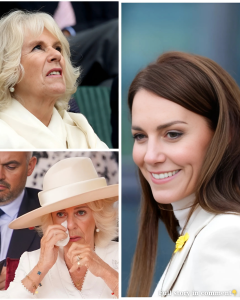The red carpet was designed to shimmer with elegance and dignity, yet on this particular evening, a single misstep transformed a carefully orchestrated royal appearance into an unforgettable spectacle. Queen Camilla, radiant in a flowing gown and glittering jewels, moved with deliberate poise as cameras clicked in rapid rhythm and whispers rippled through the crowd. But as her heel caught the carpet’s edge, the air shifted. A sudden falter, the sharp intake of gasps, and the queen’s visible struggle for balance became the night’s defining moment. For a fleeting second, time seemed to freeze. Her widened eyes, trembling hands, and forced smile revealed not only a stumble but also the fragility of a woman whose every step is judged under the heaviest of expectations.
Though Camilla quickly regained her composure, the symbolism of her falter struck deeper than a misplaced heel. For some, it mirrored the fragile acceptance she has long fought for within the monarchy, each slip magnified by history’s lingering doubts about her place. For others, her recovery was a testament to resilience the quiet determination to rise even when dignity seems fractured. Yet as the queen steadied herself, the focus of the crowd and the cameras shifted not only to her but to the younger royals standing behind her. Prince William and Catherine, composed as ever, exchanged glances, their lips betraying the faintest tremor of a smile. To some observers, it was harmless-a nervous reaction in a tense moment. To others, it was cruelty cloaked in composure. The sharp contrast between Camilla’s visible vulnerability and the couple’s restrained amusement became an image too powerful to ignore.

What might have been a minor accident spiraled instantly into a narrative larger than itself. Guests whispered, questions buzzed, and within moments, phones lit up as social media transformed the stumble into a storm. Memes and slow-motion clips circulated with captions that sharpened the contrast between sympathy and mockery. “Did the future king laugh at his stepmother?” asked one viral post. Commentators split quickly into camps: some defending William and Catherine as human and nervous in an awkward moment, others condemning their reaction as disrespectful to the queen. Headlines the next morning reduced the evening to a few frozen frames-Camilla’s stumble beside the younger royals’ smirks-an image replayed endlessly on screens, talk shows, and analysis segments. Body language experts joined the fray, parsing expressions for intent, declaring the smirk to be more than just nerves. Whether meant as lightness or ridicule, the moment had escaped the control of its participants.
Inside the palace, the weight of perception pressed heavily. Camilla carried her humiliation with silent determination, privately acknowledging the sting but publicly refusing to falter again. To her, the stumble was not merely a misstep but another reminder of the fragile balance she has walked for decades, a crown resting on a foundation that still feels unsteady. In another wing, William and Catherine wrestled with the reality that their fleeting glance, innocent or not, was now history’s shadow. They reasoned it had been nerves, a smile born of awkwardness, not malice. But once captured by cameras, the nuance no longer mattered. A glance had become a story, and a story had become a symbol.
The public reaction revealed the monarchy’s enduring paradox: royals are expected to embody both humanity and perfection, yet when their humanity shows, it is often interpreted as imperfection. For younger audiences, the moment humanized the royals, proving even queens stumble and even heirs laugh. For traditionalists, it was a breach of dignity, a sign of division within a family meant to project unity. The debate cut along generational, cultural, and emotional lines, but one truth was clear-this single moment of imbalance had revealed more about the institution’s fragile image than any speech or carefully crafted appearance.
What lingered was not the slip itself, but the echo of laughter, whether born of nerves or amusement. A smile caught in the wrong second became the story the world would remember. And therein lies the power of storytelling in the modern age. In a world where images move faster than context, where perception often outweighs intention, the smallest gestures become symbols, shaping narratives far beyond their origin. For Camilla, the stumble will be remembered as another test of resilience. For William and Catherine, the smirk will follow as a reminder of how thin the line is between humanity and harsh judgment. And for all who watched, it is a lesson in how storytelling now belongs not to those who live it, but to those who capture and share it. In the end, the red carpet did not simply host a royal appearance; it became a stage where one stumble, one smile, and one smirk reflected the immense weight of perception -and the enduring truth that in today’s world, it is not just what happens, but how it is seen, remembered, and retold that defines the story.